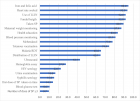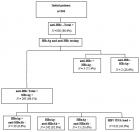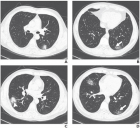Table of Contents
Cytomegalovirus infection in native kidney biopsy
Published on: 17th December, 2019
OCLC Number/Unique Identifier: 9272394400
A 61-year-old Brazilian black woman consulted with a nephrologist due to proteinuria identified on a routine urine test. She has a personal history of thymoma resection five years ago, followed by multiple episodes of pulmonary infections including mycobacteriosis, recurrent mucocutaneous candidiasis, and paraneoplastic pemphigus. Physical examination showed no edema or hypertension and laboratory tests identified proteinuria of 2.43 g/day without hematuria, serum creatinine of 0.69 mg/dl, urea 34 mg/dl, serum albumin of 2.4 g/dl, hemoglobin 10.9 g/dl, platelets 292,000/mm3, leukocytes 4950/mm3, lymphocytes 594/mm3 and neutrophils 3910/mm3. The hemolysis tests were negative and serum iron was low. Analysis of glicemia and serum lipids levels were normal as well as serum complement and imunoglobulins, except for an IgM level of 283 mg/dl (normal values 40 to 230 mg/dl) and undetectable IgE. Serologies for Syphilis, HIV, hepatitis B, C and antibodies for autoimmune diseases were negative.
A pilot study on treatment of infantile cystinosis with mesenchymal stem cells
Published on: 9th December, 2019
OCLC Number/Unique Identifier: 9272394663
Infantile cystinosis is a lysosomal storage disease leading to end stage kidney disease at early ages. There is no effective treatment and patients require long term dialysis or kidney transplant for survival. We present our experience on three affected children who received HLA matched allogeneic stem cell transplant. The protocol used was novel and designed to promote engraftment. The primary endpoint was safety for treatment related mortality or morbidity; All three children survived without serious adverse effects during extended follow up for over 4 years. Although we could not prove engraftment, all three children met secondary end point of sustained target functions over a 6 month follow-up. Further studies are warranted to further evaluate safety and efficacy of MSC treatment for infantile cystinosis.
Effect of intradialytic physical activity on the quality of life, biological parameters and sleep in hemodialysis patients
Published on: 22nd November, 2019
OCLC Number/Unique Identifier: 8405209940
Many side effects, in addition to those of the pathology itself, have occurred with hemodialysis treatment but existing literature have shown that physical activity is beneficial to hemodialysis patients. Nevertheless, our parameters have not been studied enough with a resistance training program. In our study we have observed the effect of a 12-week intradialytic resistance training program (T0 vs T12) on the quality of life using the KDQOL-SF questionnaire, blood samples biological parameters and sleep using the Epworth scale and the International restless legs syndrome study group scale. The resistance training program consists of 3 sessions per week and involved lower extremities thanks to elastic band and soft ball. After the training program, the quality of life score trend to the increase at T12 compared to T0. Among the biological parameters, the only trend decrease observed was in the C-reactive protein and a trend increase was observed in urea at T12. Dialysis efficiency presented no changes and no significant results were observed for sleep. Some trends were observed as a result of our program. The type of exercise seems to have different effects on measured parameters. Nevertheless, exercise was beneficial to chronic hemodialysis patients and seemed to improve their health.
Diabetes and chronic kidney disease: a rare cause for a very common association
Published on: 20th November, 2019
OCLC Number/Unique Identifier: 8404983788
The authors present the case of a 45-year-old female patient with diabetes and chronic kidney disease (CKD). She had unsatisfactory glycemic control, and showed some intellectual limitations. Her urine exam was unremarkable, and her renal ultrasound revealed single right kidney with aspects suggesting ureteropelvic junction syndrome. Her mother had also suffered from diabetes and CKD G5D presenting in the sixth to seventh decade.
An hereditary cause for CKD was considered, which led the authors to investigate an autosomal dominant cause for CKD with a tubulointerstitial phenotype, taking into account the personal and family history for diabetes and also the renal imaging; a large deletion in the HNF-1β gene was identified through Multiplex Ligand Probe Assay (MLPA) analysis, explaining the phenotype.
Genetic causes of CKD should be considered in the presence of positive family history for CKD, and the coexistence of diabetes with bland urine sediment should raise the possibility of a syndromic cause of the phenotype, namely involving HNF-1β gene mutations or deletions.
Weight loss counseling for dialysis patients to prepare for transplant
Published on: 2nd September, 2019
OCLC Number/Unique Identifier: 8253144962
Obesity has become a worldwide Epidemic affecting more than 300 million people. Overweight is defined as BMI (Body Mass Index) of 25-29.9 kg/m2. Obesity is defined as BMI greater than 30 kg/m2, and Morbid Obesity is a BMI of > than 35 kg/m2 [1].

HSPI: We're glad you're here. Please click "create a new Query" if you are a new visitor to our website and need further information from us.
If you are already a member of our network and need to keep track of any developments regarding a question you have already submitted, click "take me to my Query."

























































































































































